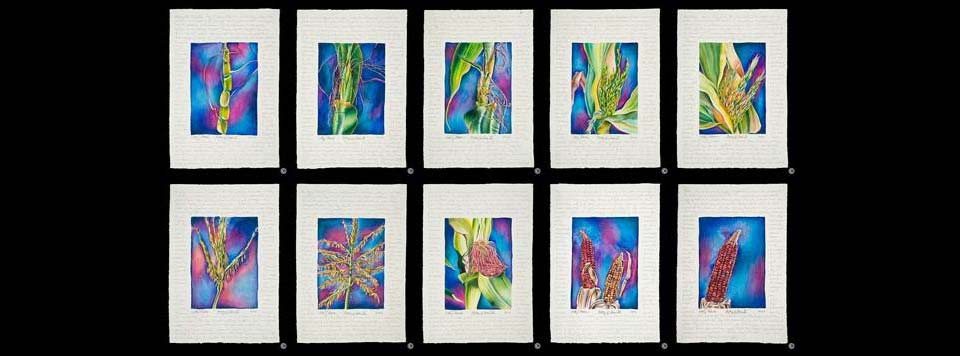This series of 10 small works on paper, 19 x13” executed in watercolor and pencil represent the history and development of corn, or maize. For more than a decade I have explored the art, culture and imagery of non-Western iconography, much of it centered on the Pre-Columbian world. This interest began as early as 1993 when I created two diptych drawings juxtapositioning man-made structures from Central America with that from nature in a series of works entitled Chaitya. In Chaitya VI the Mayan Temple of the Moon at Tikal, a temple I actually climbed, was compared to the beauty and complexity of a Mockingbird’s nest. In Chaitya VII the subject was sculptural architecture from the façade of the Temple of Quetzalcoatl at Teotihuacán and the compared image, a skull of a Grouse.
Later in a drawing from a 1995 series called Natural History VII, the Toltec image of Xipe (Our Lord the Flayed One) is introduced to the spiny skin of a sweet pineapple. Xipe is the god of spring renewal, of sprouting green plants, and the coming rains. New vegetation and the sprouting crops were symbolized by priests donning the skin of flayed sacrificial victims. These rituals took place after planting. Death was seen as necessary for life, sacrificial victims were selected and had their hearts cut out. The heart represented the center of the blood supply. Victims were skinned. Priests of Xipe wore their skins 18-20 days in honor of Xipe. At the end of 20 days, the skin would have rotted and like the shoot of a new plant, the human would emerge. Xipe represents the imitation of the plant cycle as related to maize. As the new plant would feed upon the decaying seed hull, so the living performer, or shaman, would wear the skin of a nurturing sacrificial victim until it rotted. If Xipe’s impersonation of life through death was successful, rain would come and the annual renewal of the agricultural cycle would occur.
In 1996, through a new series of works titled Sacred Drawings, I developed a work on paper, again using the diptych format. The top portion was executed in acrylic and depicted life teaming from a rainforest. The lower portion of the work was derived from the Pyramid of the Niches from the Veracruz civilization at El Tajin (see Sacred Drawing III). Central to this piece is my drawing of the great stone carving from the Main Ball Court depicting a human heart sacrifice.
Sacred Drawing IX and Sacred Drawing XI continue to explore Mesoamerican themes based on the cosmos, the World Tree, and linear images from Mesoamerican lintels. In Sacred Drawing XI I draw upon the Mayan creation theme based on Teosinte (the wild grass from which corn was cultivated) bursting through the shell of a tortoise floating in a vast cosmic primordial sea. It is the research invested in this work that led me to develop my latest series of works, History of Corn I –X.
In the History of Corn series I not only studied the pollination, cultivation, and evolution of corn, but also examined stories handed down through Native American culture. Pre-Columbian people held corn in high esteem and considered it to be a divine grain. Native American storytellers spun various tales, in which this idea is symbolized as corn being a special gift from the “great spirit.” Embedded in the background of these works is text by Henry Wadsworth Longellow’s Blessing the Cornfield from The Song of Hiawatha, as well as Cherokee and Choctaw legends.
History of Corn (full series) • watercolor and pencil • 2010 • 19″x13″ • $7000 (full series; drawings are also individually priced)


